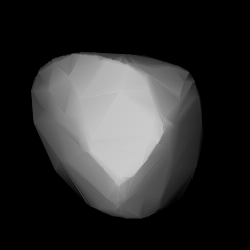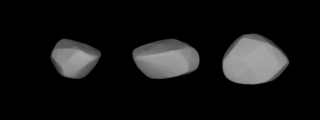Related Research Articles
4349 Tibúrcio, provisional designation 1989 LX, is a dark asteroid from the central region of the asteroid belt, approximately 29 kilometers in diameter. It was discovered on 5 June 1989, by German astronomer Werner Landgraf at ESO's La Silla Observatory in northern Chile.
La Paz, provisional designation 1923 PD, is a carbonaceous asteroid from the outer region of the asteroid belt, approximately 40 kilometers in diameter. It was discovered on 31 October 1923, by German astronomer Max Wolf at the Heidelberg-Königstuhl State Observatory and named after the city La Paz in Bolivia.

1073 Gellivara, provisional designation 1923 OW, is a dark Themistian asteroid, approximately 27 kilometers in diameter, located in the outer regions of the asteroid belt. It was discovered by Austrian astronomer Johann Palisa at the Vienna Observatory on 14 September 1923, and later named after the Swedish town of Gällivare.
1031 Arctica, provisional designation 1924 RR, is a dark asteroid from the outer region of the asteroid belt, approximately 75 kilometers in diameter. It was discovered on 6 June 1924, by Soviet−Russian astronomer Sergey Belyavsky at Simeiz Observatory on the Crimean peninsula. It was named for the Arctic Sea.

1054 Forsytia is a dark background asteroid, approximately 46 kilometers in diameter, from the outer regions of the asteroid belt. It was discovered on 20 November 1925, by astronomer Karl Reinmuth at the Heidelberg-Königstuhl State Observatory in southwest Germany and assigned provisional designation 1925 WD. It is named after the flowering plant forsythia, and marks the beginning of a sequence of 28 thematically named asteroids by the discoverer.
1462 Zamenhof, provisional designation 1938 CA, is a carbonaceous Themistian asteroid from the outer regions of the asteroid belt, approximately 27 kilometers in diameter. It was discovered on 6 February 1938, by Finnish astronomer Yrjö Väisälä at the Iso-Heikkilä Observatory in Finland. The asteroid was named after L. L. Zamenhof, the creator of Esperanto. It is a recognized Zamenhof-Esperanto object.
1114 Lorraine, provisional designation 1928 WA, is a very dark background asteroid from the outer regions of the asteroid belt, approximately 70 kilometers in diameter. It was discovered by Alexandre Schaumasse at Nice Observatory in 1928, and named for the French region of Lorraine.
1154 Astronomia, provisional designation 1927 CB, is a carbonaceous background asteroid from the outer regions of the asteroid belt, approximately 60 kilometers in diameter. It was discovered by German astronomer Karl Reinmuth at the Heidelberg-Königstuhl State Observatory on 8 February 1927. The asteroid was named for the natural science of astronomy.
1159 Granada, provisional designation 1929 RD, is a dark background asteroid and relatively slow rotator from the inner regions of the asteroid belt, approximately 30 kilometers in diameter. It was discovered on 2 September 1929, by astronomer Karl Reinmuth at the Heidelberg Observatory in southwest Germany. The asteroid was named for the Spanish city and province of Granada.

1165 Imprinetta, provisional designation 1930 HM, is a carbonaceous Meliboean asteroid from the outer regions of the asteroid belt, approximately 49 kilometers (30 mi) in diameter. It was discovered on 24 April 1930 by Dutch astronomer Hendrik van Gent at the Union Observatory in Johannesburg, South Africa. The asteroid was named after Imprinetta Gent, wife of the discoverer.
6349 Acapulco, provisional designation 1995 CN1, is a dark Adeonian asteroid from the middle region of the asteroid belt, approximately 22 kilometers in diameter.
1815 Beethoven, provisional designation 1932 CE1, is a carbonaceous background asteroid from the outer regions of the asteroid belt, approximately 30 kilometers (19 miles) in diameter. It was discovered on 27 January 1932, by German astronomer Karl Reinmuth at the Heidelberg Observatory. The uncommon F-type asteroid seems to have a long rotation period of 54 hours (tentative). It was named after Ludwig van Beethoven.

1241 Dysona, provisional designation 1932 EB1, is a dark background asteroid from the outer regions of the asteroid belt, approximately 77 kilometers in diameter. It was discovered on 4 March 1932, by English astronomer Harry Edwin Wood at the Union Observatory in Johannesburg, South Africa. The asteroid was named after English astronomer Frank Watson Dyson.
1267 Geertruida, provisional designation 1930 HD, is a carbonaceous background asteroid from the inner regions of the asteroid belt, approximately 20 kilometers in diameter. Discovered by astronomer Hendrik van Gent at Johannesburg Observatory in 1930, the asteroid was later named after Geertruid Pels, sister of Dutch astronomer Gerrit Pels.
1261 Legia, provisional designation 1933 FB, is a dark Themistian asteroid from the outer regions of the asteroid belt, approximately 32 kilometers in diameter. It was discovered on 23 March 1933, by astronomer Eugène Delporte at the Royal Observatory of Belgium in Uccle. The asteroid was named for the Belgian city of Liège (Luke).
1347 Patria, provisional designation 1931 VW, is a carbonaceous asteroid from the background population of the central asteroid belt, approximately 32 kilometers in diameter. It was discovered on 6 November 1931, by Soviet astronomer Grigory Neujmin at the Simeiz Observatory on the Crimean peninsula. The asteroid was named for the Latin word of fatherland.
1306 Scythia, provisional designation 1930 OB, is a dark Ursula asteroid from the outer regions of the asteroid belt, approximately 72 kilometers in diameter. It was discovered on 22 July 1930, by Soviet astronomer Grigory Neujmin at the Simeiz Observatory on the Crimean peninsula. The asteroid was named for the historic region of Scythia.
1258 Sicilia, provisional designation 1932 PG, is a dark background asteroid from the outer regions of the asteroid belt, approximately 44 kilometers in diameter. It was discovered on 8 August 1932, by astronomer Karl Reinmuth at the Heidelberg-Königstuhl State Observatory in southwest Germany. The asteroid was named after the Italian island of Sicily.
1242 Zambesia is a dark background asteroid from the central regions of the asteroid belt, approximately 48 kilometers in diameter. It was discovered on 28 April 1932, by South African astronomer Cyril Jackson at the Union Observatory in Johannesburg. The asteroid was named for the large Zambezi basin in southern Africa.
1296 Andrée, provisional designation 1933 WE, is a stony Nysian asteroid from the inner regions of the asteroid belt, approximately 25 kilometers in diameter. It was discovered on 25 November 1933, by French astronomer Louis Boyer at the North African Algiers Observatory, Algeria, and named after the discoverer's niece.
References
- 1 2 3 4 5 6 7 "1421 Esperanto (1936 FQ)". Minor Planet Center. Retrieved 9 December 2018.
- 1 2 3 4 "JPL Small-Body Database Browser: 1421 Esperanto (1936 FQ)" (2018-09-18 last obs.). Jet Propulsion Laboratory. Archived from the original on 20 August 2020. Retrieved 9 December 2018.
- 1 2 "Asteroid 1421 Esperanto". Small Bodies Data Ferret. Retrieved 9 December 2018.
- 1 2 "Asteroid (1421) Esperanto – Proper elements". AstDyS-2, Asteroids – Dynamic Site. Retrieved 4 December 2018.
- 1 2 3 4 Tedesco, E. F.; Noah, P. V.; Noah, M.; Price, S. D. (October 2004). "IRAS Minor Planet Survey V6.0". NASA Planetary Data System – IRAS-A-FPA-3-RDR-IMPS-V6.0: IRAS-A-FPA-3-RDR-IMPS-V6.0. Bibcode:2004PDSS...12.....T . Retrieved 9 December 2018.
- 1 2 3 4 Mainzer, A. K.; Bauer, J. M.; Cutri, R. M.; Grav, T.; Kramer, E. A.; Masiero, J. R.; et al. (June 2016). "NEOWISE Diameters and Albedos V1.0". NASA Planetary Data System: EAR-A-COMPIL-5-NEOWISEDIAM-V1.0. Bibcode:2016PDSS..247.....M . Retrieved 9 December 2018.
- 1 2 3 4 Masiero, Joseph R.; Mainzer, A. K.; Grav, T.; Bauer, J. M.; Cutri, R. M.; Nugent, C.; et al. (November 2012). "Preliminary Analysis of WISE/NEOWISE 3-Band Cryogenic and Post-cryogenic Observations of Main Belt Asteroids". The Astrophysical Journal Letters. 759 (1): 5. arXiv: 1209.5794 . Bibcode:2012ApJ...759L...8M. doi:10.1088/2041-8205/759/1/L8. S2CID 46350317.
- 1 2 3 4 Usui, Fumihiko; Kuroda, Daisuke; Müller, Thomas G.; Hasegawa, Sunao; Ishiguro, Masateru; Ootsubo, Takafumi; et al. (October 2011). "Asteroid Catalog Using Akari: AKARI/IRC Mid-Infrared Asteroid Survey". Publications of the Astronomical Society of Japan. 63 (5): 1117–1138. Bibcode:2011PASJ...63.1117U. doi:10.1093/pasj/63.5.1117. (online, Usui Fumihiko (2013). Mid-Infrared Asteroid Survey with AKARI [「あかり」衛星による小惑星の中間赤外線サーベイ] (Thesis). Vol. Thesis or Dissertation. p. 153(p.1-178).)
- 1 2 3 4 Nugent, C. R.; Mainzer, A.; Masiero, J.; Bauer, J.; Cutri, R. M.; Grav, T.; et al. (December 2015). "NEOWISE Reactivation Mission Year One: Preliminary Asteroid Diameters and Albedos". The Astrophysical Journal. 814 (2): 13. arXiv: 1509.02522 . Bibcode:2015ApJ...814..117N. doi:10.1088/0004-637X/814/2/117. S2CID 9341381.
- 1 2 3 4 Nugent, C. R.; Mainzer, A.; Bauer, J.; Cutri, R. M.; Kramer, E. A.; Grav, T.; et al. (September 2016). "NEOWISE Reactivation Mission Year Two: Asteroid Diameters and Albedos". The Astronomical Journal. 152 (3): 12. arXiv: 1606.08923 . Bibcode:2016AJ....152...63N. doi: 10.3847/0004-6256/152/3/63 .
- 1 2 Ferrero, Andrea (July 2012). "Lightcurve Photometry of Six Asteroids". The Minor Planet Bulletin. 39 (3): 138–139. Bibcode:2012MPBu...39..138F. ISSN 1052-8091.
- 1 2 3 4 "LCDB Data for (1421) Esperanto". Asteroid Lightcurve Database (LCDB). Retrieved 9 December 2018.
- ↑ Schmadel, Lutz D. (2009). "Appendix – Publication Dates of the MPCs". Dictionary of Minor Planet Names – Addendum to Fifth Edition (2006–2008). Springer Berlin Heidelberg. p. 221. Bibcode:2009dmpn.book.....S. doi:10.1007/978-3-642-01965-4. ISBN 978-3-642-01964-7.